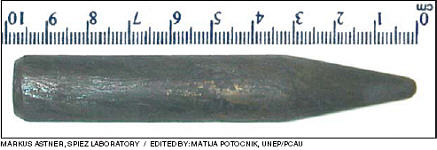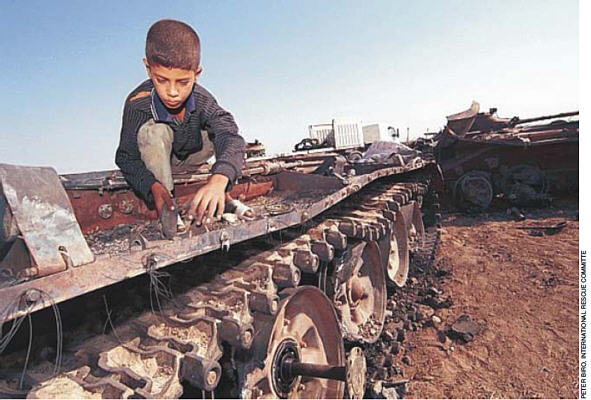Excerpt on DU
from Environment in Iraq: UNEP Progress Report
Geneva, 20 October 2003
【劣化ウランに関する抜粋】
「イラクの環境:UNEP 進捗報告」より
ジュネーブ 2003年8月20日
United Nations Environment Programme (UNEP)
国連環境計画(UNEP)
この文書は、国連環境計画(UNEP)が2003年8月に発表した報告書 "Environment in Iraq: UNEP Progress Report" から劣化ウランに関する部分を抜粋し日本語訳したものである。
翻訳は
http://postconflict.unep.ch/publications/Iraq_PR.pdf
に基づいている。
和訳独立版はこちらからどうぞ。
【TriNary :: Transcript 劣化ウラン概要報告シリーズ】
- IAEA(2003) 『劣化ウランFAQ集』
[ 和訳 ]
[ 対訳 ]
- UNEP(2003) 『劣化ウラン概況報告書』
[ 和訳 ]
[ 対訳 ]
- UNEP(2003) 『【劣化ウランに関する抜粋】
「イラクの環境:UNEP 進捗報告」より』
[ 和訳 ]
[ 対訳 ]
- UNEP(2003) 『【劣化ウランに関する抜粋】
「イラクの環境に関する机上調査」より』
[ 和訳 ]
[ 対訳 ]
- WHO(2003) 『概況報告書 第257号 - 劣化ウラン』
[ 和訳 ]
[ 対訳 ]
- WHO(2001) 『劣化ウラン:原因、被曝および健康への影響 ― 概要 ― 』
[ 和訳 ]
[ 対訳 ]
2. Environmental priority sites
2. 環境上の優先事項
2.7 Use of depleted uranium
2.7 劣化ウランの使用
The 1991 Gulf War was the first conflict in which depleted uranium (DU) munitions
were used extensively. A total of about 300 tonnes of DU were fired by the US and the
UK during this war, with DU remaining in the environment as dust or small fragments.
1991年の湾岸戦争は劣化ウラン弾が広範囲で使用された最初の紛争であった。この戦争で、総計およそ 300トンの DU が米英軍によって発射され、DU は塵や小片として環境に残存している。
The US Department of Defense and the UK Ministry of Defence have admitted that
the American and British coalition forces also used ammunition made from DU in
the 2003 Iraq War. British Challenger tanks, for example, expended 1.9 tonnes of
DU munitions, approximately twice as much as UK troops used in the 1991 Gulf
War. DU was used in tank battles, also involving UK troops, to the west and southwest
of Al Basrah.
アメリカ国防総省とイギリス国防省は、米英連合軍が2003年のイラク戦争でも DU から作られた弾薬を使用したことを認めている。例えば、イギリス軍チャレンジャー戦車は 1.9トンの劣化ウラン弾を消費したが、これは1991年の湾岸戦争でイギリス軍の使用した量の約二倍である。イギリス軍も参加したアル・バスラ西方および南西での戦車戦でも DU は使用された。
The UK Ministry of Defence has provided UNEP with details of British DU target locations
and has offered to provide advice on carrying out risk assessments on DU
within urban areas, and on long-term monitoring of DU in the environment, including
water resources. According to the UK Ministry of Defence, target areas are
likely to be at a maximum distance of 3 km from firing positions. In June 2003,
scientists from the UK Ministry of Defence completed a preliminary technical assessment
of some Iraqi tanks thought to have been struck by DU rounds. So far, the
UK Ministry of Defence findings indicate very low levels of DU in the vicinity of these
tanks. Most of the heavy military equipment has been moved, mainly by troops,
from the battlegrounds to scrap areas. While this made it difficult for the UK scientists
to find remaining tanks or other heavy military equipment in the actual areas
of battle, the scientists noted that most of the tanks found showed low levels of
radioactivity, and were clearly marked with paint indicating that they had been hit
by DU ammunition.
イギリス国防省はイギリス軍が DU の標的とした場所の詳細な位置を UNEP に提供し、都市部での DU の危険評価の実行や水資源を含む環境における DU の長期的監視に関する助言の提供を申し出ている。イギリス国防省によると、標的となった地域は射撃地点から最大 3 km の距離にあるらしい。2003年6月に、イギリス国防省から派遣された科学者が DU が命中したと考えられるイラク軍戦車の一部について予備的な技術的評価を完了した。今までのところ、イギリス国防省の調査結果はこれらの戦車の近くから検出された DU が非常に低いレベルにあると示している。重軍事装備のほとんどが、主に軍によって、戦場から廃棄地域に撤去されている。これはイギリスの科学者が残りの戦車や他の重軍事装備を実際の戦場で見つけることを困難にしているが、科学者たちは発見された戦車のほとんどが低レベルの放射能を示すことを観測しており、劣化ウラン弾の命中を示す印を塗料ではっきりと残している。

DU 貫通体の実際の大きさ
MARKUS ASTNER, SPIEZ LABORATORY / EDITED BY: MATIJA POTOCNIK, UNEP/PCAU

DU によって潜在的に汚染された戦車からアルミニウムや他の売れる金属を剥がす、アヤド(11歳)
PETER BIRO, INTERNATIONAL RESCUE COMMITTEE
UNEP has not received information from the US on any environmental assessment or remediation of DU
contamination in Iraq.
UNEP はイラクの劣化ウラン汚染に関する環境評価やその対策のいずれについても、アメリカからは情報を受け取っていない。
The quantities of DU expended in the US air operations, tank battles and ground operations are still unknown.
The vehicles that usually carry DU munitions - Abrams tanks (M1A1, M1A2), Bradley Fighting Vehicles
(M2) and Light Armoured Vehicles (LAV-25) - were involved in the fighting. There is currently no evidence
that missiles or bombs used during the war - particularly the AGM-86D CALCM hard target penetrators (153
were used) or bunker-busting bombs - contain DU.
アメリカ軍の空爆作戦、戦車戦および地上作戦で消費された DU の量はいまだ不明である。劣化ウラン弾を通常装備している車両 ― エイブラムス戦車(M1A1, M1A2)、ブラッドレー歩兵戦闘車(M2)および軽装甲車(LAV-25) ― が戦闘に参加している。この戦争で使用されたミサイルや爆弾 ― 特に AGM-86D CALCM 硬化目標貫通体(153発使用された)や地下施設破壊爆弾(バンカー・バスター) ― に DU が含まれている証拠は今のところ全く無い。
The media occasionally showed footage of scrap areas holding destroyed Iraqi vehicles. These pictures
also made it evident that local people usually had free access to these areas and were extracting material
such as iron plates. It can be expected that these areas contain vehicles hit by DU. Without delay, therefore,
vehicles in these areas should be investigated, and those hit by DU should be removed to areas where
access is strictly controlled.
メディアは時折破壊されたイラク軍の車両を保管している廃棄地域の映像を放映した。これらの映像により、地元住民がこれらの地域に自由に侵入して、鉄板のような資材を持ち出しているのが明らかとなった。これらの地域には DU が命中した車両が含まれていると予想される。したがって、早急に、これらの地域の車両を調査し、DU が命中した車両を、人々の立ち入りを厳しく制限する地域へ撤去すべきである。
According to a recent IAEA report, published in August 2003, depleted uranium from munitions used in the
1991 Gulf War does not pose a long-term radiological hazard to the people of Kuwait. The Kuwait government
requested, in February 2002, the IAEA to assess possible long-term radiological impacts of DU residues
at 11 locations in Kuwait. Although the findings of this report are not alarming, further policy action and
additional research are needed to resolve the uncertainties regarding the use and effects of DU munitions
in the Iraq wars. Based on available information, much of the DU expenditure used during the 2003 conflict
appears to be in or near urban areas, where people live, work, draw water and grow food. Therefore,
contaminated areas need to be identified and assessed, and the population should be tested and monitored.
People generally are clearly unaware of the risks of exposure to DU. Urgent steps need to be taken to
raise awareness of the potential risks and to introduce protection measures, including posting of warning
signs and restricting access at contaminated locations and storage sites.
2003年8月に発表された IAEA の最新レポートによると、1991年の湾岸戦争で使用された兵器による劣化ウランはクウェートの人々に長期的な放射線障害を引き起こさないという。クウェート政府は、2002年2月にクウェートの11の場所で DU 残留物によって引き起こされうる長期的な放射線被害について調査するよう IAEA に要請した。このレポートの調査結果は急を知らせるようなものではないが、さらなる政策的措置と追加調査がイラク戦争における劣化ウラン弾の使用と影響に関して不明な点を解決するのに必要である。入手可能な情報に基づくと、2003年の紛争で使用された DU のほとんどが都市部およびその近郊で消費されており、そこでは住民が生活し、働き、水を引いて食べ物を育てているようである。したがって、汚染地域を特定および評価し、住民を検査し観察するべきである。概して人々は DU 被曝の危険にまったくと言って気づいていない。潜在的な危険について注意を喚起し予防策を宣伝すべく、警告の貼り紙や、汚染地点や保管地区への立ち入りの制限といった、緊急的な措置が取られることが必要である。
ANNEX 2: REFERENCES
付録 2: 参考文献
2. Environmental priority sites
2. 環境上の優先事項
http://www.iaea.org/worldatom/Press/Focus/IaeaIraq/chrono_jan_03.shtml
http://www.mod.uk/issues/depleted_uranium/middle_east_2003.htm
http://www.urbanoperations.com/oifcentaf.pdf
http://www.antenna.nl/wise/uranium/pdf/duiq03.pdf
http://www.mod.uk/issues/depleted_uranium/gulf_safety_instructions.htm
http://www.eoslifework.co.uk/u231.htm
http://www.antenna.nl/wise/uranium/pdf/duiq03.pdf
The Use of DU in the Iraq War: An Initial Assessment of Information and Policies, Dan Fahey, June 2003
【訳者後記】
アヤド……、恐ろしい子。
というか、途中ですでに翻訳してる人を見つけました。がっくし。
http://www.nodu.net/du/UNEP_ProgressReport.htm
でも、せっかくだから、拙訳も公開します。微妙に違うところもあるかもしれないし。
公開:2005/10/09
---
ただし、この日本語訳は国際連合の著作権を侵害してるかもしれません。
http://www.unep.org/Documents.Multilingual/Default.asp?DocumentID=289&ArticleID=3446
http://www.unep.org/Documents.Multilingual/Default.asp?DocumentID=289&ArticleID=3447
国連からクレームがくれば引っ込めます。そんな素敵な事件が起こるとは思えないけれど。
それらの点を踏まえて使ってください。自己責任で。
この日本語訳は非公式なものです。UNEPの見解を正確に伝えているという保証はありません。




